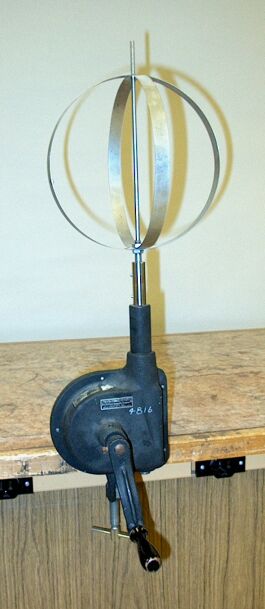
Two metal bands are attached to a vertical rod at right angles, the rod passing through a diameter of each band. The bands are affixed to the rod near the bottom, but can slide along the rod at the top. As you turn the crank, the rod and bands begin to spin. This causes the hoops to bulge outward at the middle, and the top of the hoops to slide downward. As you turn the crank faster and faster, this flattening of the bands becomes more and more pronounced.
The apparatus in the photograph above has two steel bands that are attached to a vertical rod at right angles, with the rod running along a diameter of each band. The bands are fixed near the bottom of the rod, but can slide along the rod at the top. The rod and the crank are connected via a gear drive so that when you turn the crank one turn, the rod and bands turn about 10-1/2 turns. This allows you to spin the rod and bands at a relatively high speed.
When you turn the crank and start the bands spinning, the rod and all points on the bands rotate with the same angular velocity ω. This gives them an instantaneous tangential velocity, v = ωr, where r is the radius of the circle along which they revolve about the rod. As the previous demonstrations in this chapter show, at any instant, in order to keep an object moving in a circular path, something must provide a sideways force on it, accelerating it toward the center of the circle – a centripetal force. This force is F = mv2/r, where m is the mass of the object, v is its tangential velocity, and r is the radius of the circle in which it travels. (See demonstration 16.03 -- Ball on turntable.) For any point on a rotating body, we can also express the centripetal force as F = mω2r. In a rotating solid object, this acceleration is provided by the intermolecular forces that hold the object together. When the bands are stationary, spring tension holds them in a circular shape. (This spring tension prevents gravity from squeezing the bands into an ellipse.) When you start the bands rotating, all points on them now have an angular velocity, ω. As we go along the bands toward the middle from either point at which they are attached to the rod, the tangential velocity, ωr, increases, and the magnitude of the force necessary to keep that part of the band moving in a circle, mv2/r, or mω2r, increases. The middle of the bands stretches outward until the additional spring tension that results, provides the necessary force to keep it rotating in a circle. As the bands bow outward at the middle, they become elliptical, and the points at which they are attached to the rods come closer together. Since the bands are fixed at the bottom, they slide down from the top; they flatten.
As you turn the crank faster and faster, and the bands spin faster and faster, the tension necessary to provide the centripetal force increases, and the bands bow more and more, becoming more and more elliptical, and the flattening increases. This phenomenon also occurs with the rotating earth. Points along the equator have the greatest tangential velocity, and thus require greater force to hold them in a circular path than do other points on the earth. Because of this, the earth bulges slightly at the equator and is somewhat flattened at the poles; it is slightly oblate.